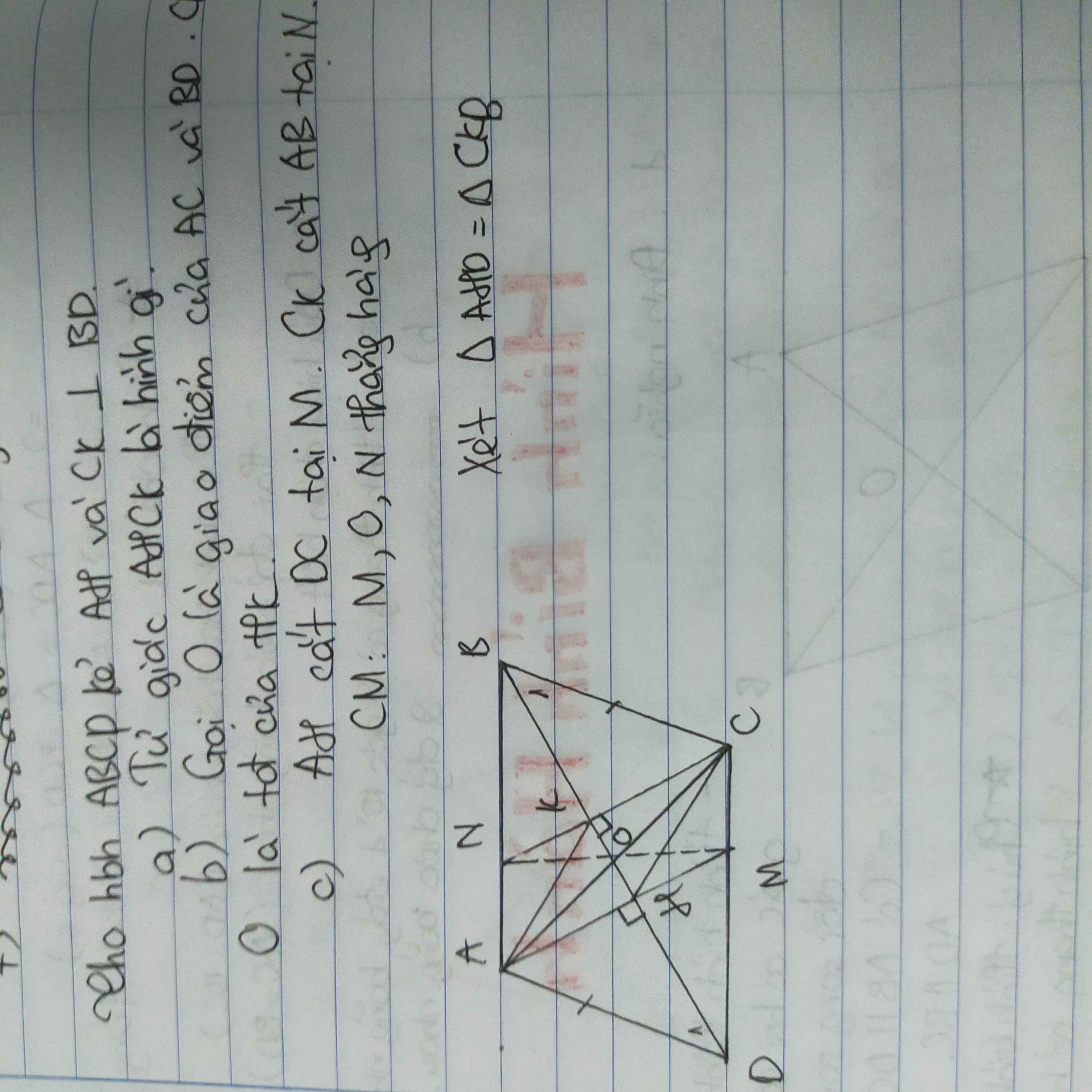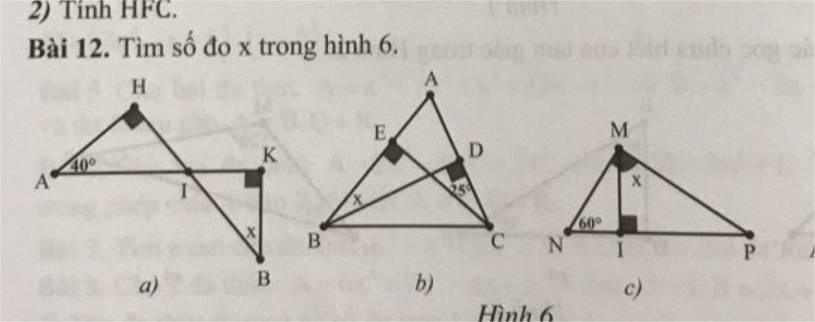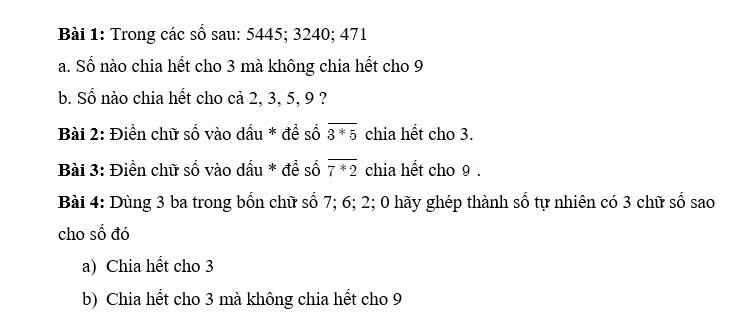
Hãy nhập câu hỏi của bạn vào đây, nếu là tài khoản VIP, bạn sẽ được ưu tiên trả lời.


\(\left|\dfrac{4}{3}x-\dfrac{1}{4}\right|>=0\forall x\)
=>\(A=\left|\dfrac{4}{3}x-\dfrac{1}{4}\right|-\dfrac{2}{11}>=-\dfrac{2}{11}\forall x\)
Dấu '=' xảy ra khi \(\dfrac{4}{3}x-\dfrac{1}{4}=0\)
=>\(\dfrac{4}{3}x=\dfrac{1}{4}\)
=>\(x=\dfrac{1}{4}:\dfrac{4}{3}=\dfrac{3}{16}\)

a: Xét ΔAHD vuông tại H và ΔCKB vuông tại K có
AD=CB
\(\widehat{ADH}=\widehat{CBK}\)(hai góc so le trong, AD//CB)
Do đó: ΔAHD=ΔCKB
=>AH=CK
Ta có: AH\(\perp\)BD
CK\(\perp\)BD
Do đó: AH//CK
Xét tứ giác AHCK có
AH//CK
AH=CK
Do đó:AHCK là hình bình hành
b: ABCD là hình bình hành
=>AC cắt BD tại trung điểm của mỗi đường
=>O là trung điểm chung của AC và BD
ta có: AHCK là hình bình hành
=>AC cắt HK tại trung điểm của mỗi đường
mà O là trung điểm của AC
nên O là trung điểm của HK
c: Xét tứ giác AMCN có
AM//CN
AN//CM
Do đó: AMCN là hình bình hành
=>AC cắt MN tại trung điểm của mỗi đường
mà O là trung điểm của AC
nên O là trung điểm của MN
=>M,O,N thẳng hàng

Câu 8:
\(x:4\times36-x:7\times28+x:4\times20=180\)
=>9x-4x+5x=180
=>10x=180
=>x=180:10=18

Bài 2:
c: \(C=27x^3-27x^2y+9xy^2-y^3-121\)
\(=\left(3x\right)^3-3\cdot\left(3x\right)^2\cdot y+3\cdot3x\cdot y^2-y^3-121\)
\(=\left(3x-y\right)^3-121=7^3-121=343-121=222\)
Bài 3:
a: \(x^2-4+\left(x-2\right)^2\)
\(=\left(x-2\right)\left(x+2\right)+\left(x-2\right)^2\)
=(x-2)(x+2+x-2)
=2x(x-2)
b: \(x^3-2x^2+x-xy^2\)
\(=x\left(x^2-2x+1-y^2\right)\)
\(=x\left[\left(x-1\right)^2-y^2\right]=x\left(x-1-y\right)\left(x-1+y\right)\)
c: \(x^3-4x^2-12x+27\)
\(=\left(x^3+27\right)-4x\left(x+3\right)\)
\(=\left(x+3\right)\left(x^2-3x+9\right)-4x\left(x+3\right)\)
\(=\left(x+3\right)\left(x^2-7x+9\right)\)
d: \(\left(x^2+x\right)^2-2\left(x^2+x\right)-15\)
\(=\left(x^2+x\right)^2-5\left(x^2+x\right)+3\left(x^2+x\right)-15\)
\(=\left(x^2+x\right)\left(x^2+x-5\right)+3\left(x^2+x-5\right)\)
\(=\left(x^2+x-5\right)\left(x^2+x+3\right)\)

a: Ta có: \(\widehat{HIA}+\widehat{HAI}=90^0\)(ΔHAI vuông tại H)
\(\widehat{KIB}+\widehat{KBI}=90^0\)(ΔKIB vuông tại K)
mà \(\widehat{HIA}=\widehat{KIB}\)(hai góc đối đỉnh)
nên \(\widehat{HAI}=\widehat{KBI}\)
=>\(x=40^0\)
b: Xét tứ giác BEDC có \(\widehat{BEC}=\widehat{BDC}=90^0\)
nên BEDC là tứ giác nội tiếp
=>\(x=\widehat{EBD}=\widehat{ECD}=35^0\)
c: Ta có: \(\widehat{IMP}+\widehat{IPM}=90^0\)(ΔMIP vuông tại I)
\(\widehat{MPN}+\widehat{MNP}=90^0\)(ΔMNP vuông tại M)
Do đó: \(x=\widehat{IMP}=\widehat{N}=60^0\)

Bài 2: Đặt *=x
Số cần tìm sẽ có dạng là \(\overline{3x5}\)
\(\overline{3x5}⋮3\)
=>\(3+x+5⋮3\)
=>\(x+8⋮3\)
=>\(x\in\left\{1;4;7\right\}\)
=>*\(\in\left\{1;4;7\right\}\)
Bài 4:
a: 720;702;270;207;762;726;627;672;276;267
b: 762; 726; 627; 672; 276; 267

a: \(\dfrac{2}{3}x\left(x^2-4\right)=0\)
=>\(x\left(x-2\right)\left(x+2\right)=0\)
=>\(\left[{}\begin{matrix}x=0\\x-2=0\\x+2=0\end{matrix}\right.\Leftrightarrow\left[{}\begin{matrix}x=0\\x=2\\x=-2\end{matrix}\right.\)
b: \(\left(x+2\right)^2-\left(x-2\right)\left(x+2\right)=0\)
=>\(\left(x+2\right)\left(x+2-x+2\right)=0\)
=>4(x+2)=0
=>x+2=0
=>x=-2
c: \(6x^3+7x^2+2x=0\)
=>\(x\left(6x^2+7x+2\right)=0\)
=>\(x\left(6x^2+4x+3x+2\right)=0\)
=>\(x\left(3x+2\right)\left(2x+1\right)=0\)
=>\(\left[{}\begin{matrix}x=0\\3x+2=0\\2x+1=0\end{matrix}\right.\Leftrightarrow\left[{}\begin{matrix}x=0\\x=-\dfrac{2}{3}\\x=-\dfrac{1}{2}\end{matrix}\right.\)
d: \(x^2+4x=7\)
=>\(x^2+4x+4=11\)
=>\(\left(x+2\right)^2=11\)
=>\(\left[{}\begin{matrix}x+2=\sqrt{11}\\x+2=-\sqrt{11}\end{matrix}\right.\Leftrightarrow\left[{}\begin{matrix}x=\sqrt{11}-2\\x=-\sqrt{11}-2\end{matrix}\right.\)

\(x+3y=5\Rightarrow x=5-3y\)
Ta có:
\(A=x^2+y^2+16y+2x\)
\(A=\left(5-3y\right)^2+y^2+16y+2\left(5-3y\right)\)
\(A=25-30y+9y^2+y^2+16y+10-6y\)
\(A=10y^2-20y+10+25\)
\(A=10\left(y-1\right)^2+25\ge5\forall y\)
Dấu "=" xảy ra khi \(y=1\Rightarrow x=2\)
Vậy \(A_{min}=25\) khi \(x=2\) và \(y=1\)







\(\left|6x+22\right|>=0\forall x;\left(y-21\right)^2>=0\forall y\)
Do đó: \(\left|6x+22\right|+\left(y-21\right)^2>=0\forall x,y\)
Dấu '=' xảy ra khi \(\left\{{}\begin{matrix}6x+22=0\\y-21=0\end{matrix}\right.\)
=>\(\left\{{}\begin{matrix}x=-\dfrac{11}{3}\\y=21\end{matrix}\right.\)